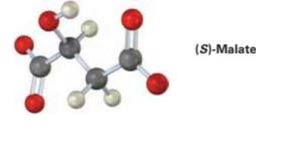
Organic Chemistry
9th Edition
ISBN: 9781305080485
Author: John E. McMurry
Publisher: Cengage Learning
expand_more
expand_more
format_list_bulleted
Concept explainers
Textbook Question
Chapter 13.7, Problem 14P
How many absorptions would you expect (S)-malate, an intermediate in carbohydrate

Expert Solution & Answer
Trending nowThis is a popular solution!

Students have asked these similar questions
Give detailed mechanism Solution with explanation needed. Don't give Ai generated solution
Show work with explanation needed....don't give Ai generated solution
1.
6. Draw the products for the following reaction:
2.
Diels-Aider
reaction
NOH O
OH
Chapter 13 Solutions
Organic Chemistry
Ch. 13.1 - Prob. 1PCh. 13.1 - Prob. 2PCh. 13.2 - Prob. 3PCh. 13.3 - The following 1H NMR peaks were recorded on a...Ch. 13.3 - When the 1Η NMR spectrum of acetone, CH3COCH3, is...Ch. 13.4 - Each of the following compounds has a single 1H...Ch. 13.4 - Identify the different types of protons in the...Ch. 13.5 - How many peaks would you expect in the 1H NMR...Ch. 13.6 - Predict the splitting patterns you would expect...Ch. 13.6 - Draw structures for compounds that meet the...
Ch. 13.6 - The integrated 1H NMR spectrum of a compound of...Ch. 13.7 - Identify the indicated sets of protons as...Ch. 13.7 - How many kinds of electronically nonequivalent...Ch. 13.7 - How many absorptions would you expect (S)-malate,...Ch. 13.8 - 3-Bromo-1-phenyl-1-propene shows a complex NMR...Ch. 13.9 - How could you use 1H NMR to determine the...Ch. 13.11 - Prob. 17PCh. 13.11 - Propose structures for compounds that fit the...Ch. 13.11 - Prob. 19PCh. 13.12 - Prob. 20PCh. 13.12 - Prob. 21PCh. 13.12 - Prob. 22PCh. 13.13 - Prob. 23PCh. 13.SE - Into how many peaks would you expect the 1H NMR...Ch. 13.SE - How many absorptions would you expect the...Ch. 13.SE - Sketch what you might expect the 1H and 13C NMR...Ch. 13.SE - How many electronically nonequivalent kinds of...Ch. 13.SE - Identify the indicated protons in the following...Ch. 13.SE - Prob. 29APCh. 13.SE - Prob. 30APCh. 13.SE - When measured on a spectrometer operating at 200...Ch. 13.SE - Prob. 32APCh. 13.SE - Prob. 33APCh. 13.SE - How many types of nonequivalent protons are...Ch. 13.SE - The following compounds all show a single line in...Ch. 13.SE - Prob. 36APCh. 13.SE - Propose structures for compounds with the...Ch. 13.SE - Predict the splitting pattern for each kind of...Ch. 13.SE - Predict the splitting pattern for each kind of...Ch. 13.SE - Identify the indicated sets of protons as...Ch. 13.SE - Identify the indicated sets of protons as...Ch. 13.SE - The acid-catalyzed dehydration of...Ch. 13.SE - How could you use 1H NMR to distinguish between...Ch. 13.SE - Propose structures for compounds that fit the...Ch. 13.SE - Propose structures for the two compounds whose 1H...Ch. 13.SE - Prob. 46APCh. 13.SE - How many absorptions would you expect to observe...Ch. 13.SE - Prob. 48APCh. 13.SE - How could you use 1H and 13C NMR to help...Ch. 13.SE - How could you use 1H NMR, 13C NMR, and IR...Ch. 13.SE - Assign as many resonances as you can to specific...Ch. 13.SE - Assume that you have a compound with the formula...Ch. 13.SE - The compound whose 1H NMR spectrum is shown has...Ch. 13.SE - The compound whose 1H NMR spectrum is shown has...Ch. 13.SE - Propose structures for compounds that fit the...Ch. 13.SE - Long-range coupling between protons more than two...Ch. 13.SE - The 1H and 13C NMR spectra of compound A, C8H9Br,...Ch. 13.SE - Propose structures for the three compounds whose...Ch. 13.SE - The mass spectrum and 13C NMR spectrum of a...Ch. 13.SE - Compound A, a hydrocarbon with M+=96 in its mass...Ch. 13.SE - Propose a structure for compound C, which has...Ch. 13.SE - Prob. 62GPCh. 13.SE - Propose a structure for compound E, C7H12O2, which...Ch. 13.SE - Compound F, a hydrocarbon with M+=96 in its mass...Ch. 13.SE - 3-Methyl-2-butanol has five signals in its 13C NMR...Ch. 13.SE - A 13C NMR spectrum of commercially available...Ch. 13.SE - Carboxylic acids (RCO2H) react with alcohols (ROH)...Ch. 13.SE - Prob. 68GPCh. 13.SE - The proton NMR spectrum is shown for a compound...Ch. 13.SE - The proton NMR spectrum of a compound with the...Ch. 13.SE - The proton NMR spectrum is shown for a compound...
Knowledge Booster
Learn more about
Need a deep-dive on the concept behind this application? Look no further. Learn more about this topic, chemistry and related others by exploring similar questions and additional content below.Similar questions
- The Ksp for lead iodide ( Pbl₂) is 1.4 × 10-8. Calculate the solubility of lead iodide in each of the following. a. water Solubility = mol/L b. 0.17 M Pb(NO3)2 Solubility = c. 0.017 M NaI mol/L Solubility = mol/Larrow_forwardPleasssssseeee solve this question in cheeemsirty, thankss sirarrow_forwardPleasssssseeee solve this question in cheeemsirty, thankss sirarrow_forward
arrow_back_ios
SEE MORE QUESTIONS
arrow_forward_ios
Recommended textbooks for you

 Organic ChemistryChemistryISBN:9781305580350Author:William H. Brown, Brent L. Iverson, Eric Anslyn, Christopher S. FootePublisher:Cengage Learning
Organic ChemistryChemistryISBN:9781305580350Author:William H. Brown, Brent L. Iverson, Eric Anslyn, Christopher S. FootePublisher:Cengage Learning Macroscale and Microscale Organic ExperimentsChemistryISBN:9781305577190Author:Kenneth L. Williamson, Katherine M. MastersPublisher:Brooks Cole
Macroscale and Microscale Organic ExperimentsChemistryISBN:9781305577190Author:Kenneth L. Williamson, Katherine M. MastersPublisher:Brooks Cole Introduction to General, Organic and BiochemistryChemistryISBN:9781285869759Author:Frederick A. Bettelheim, William H. Brown, Mary K. Campbell, Shawn O. Farrell, Omar TorresPublisher:Cengage Learning
Introduction to General, Organic and BiochemistryChemistryISBN:9781285869759Author:Frederick A. Bettelheim, William H. Brown, Mary K. Campbell, Shawn O. Farrell, Omar TorresPublisher:Cengage Learning


Organic Chemistry
Chemistry
ISBN:9781305580350
Author:William H. Brown, Brent L. Iverson, Eric Anslyn, Christopher S. Foote
Publisher:Cengage Learning

Macroscale and Microscale Organic Experiments
Chemistry
ISBN:9781305577190
Author:Kenneth L. Williamson, Katherine M. Masters
Publisher:Brooks Cole

Introduction to General, Organic and Biochemistry
Chemistry
ISBN:9781285869759
Author:Frederick A. Bettelheim, William H. Brown, Mary K. Campbell, Shawn O. Farrell, Omar Torres
Publisher:Cengage Learning
NMR Spectroscopy; Author: Professor Dave Explains;https://www.youtube.com/watch?v=SBir5wUS3Bo;License: Standard YouTube License, CC-BY